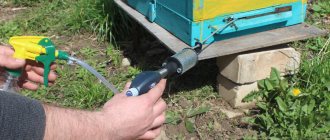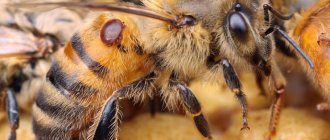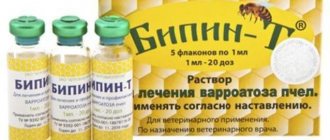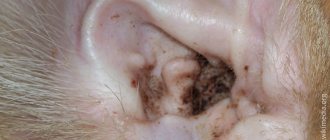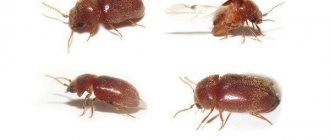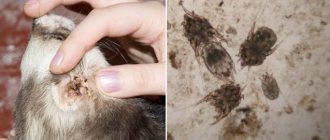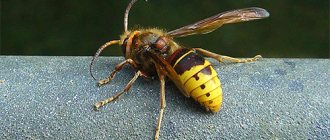Treating bees against mites: effective control of parasites. What products are the most effective in the fight against ticks? Composition and mechanism of action. Advantages, features and disadvantages of popular means. What you need to know about the treatment of bees and preventive protective measures.
Beekeepers are well aware of the danger that mites pose to bee colonies. In addition to the fact that these parasites greatly annoy bees, they are capable of transmitting viral diseases. If an infection occurs, bees must be treated for mites.
There are many options for combating these parasites; you can use chemicals, folk remedies, or apply mechanical or biological methods. Next, we’ll look at the most popular and effective methods that will help you quickly fix the problem.
Symptoms and signs of occurrence
Mites are quite small and have a protective coloring, so it is difficult to see them on bees. However, there are many symptoms that allow you to determine the presence of a parasitic infestation.
These include:
- change in body shape of adult bees;
- reduction in the number of brood;
- reduction in the thickness of the fat layer in larvae;
- loss of adult flight ability;
- slower collection of nectar and pollen;
- lethargy of insects.
Weakened adults emerge from the affected brood. Bees infected with mites cannot properly prepare for winter.
General characteristics of the disease
Varroatosis is a dangerous pathology. It affects any bees - both adults and larvae. The danger of the disease is that at the initial stage it can rarely be detected due to the absence of obvious clinical signs.
Varroatosis is a quarantine disease, since the degree of its contagiousness is very high.
Insects affected by varroa do not form a club in the fall. They do not tolerate the winter period well. It is possible to awaken in the first half of winter.
How does the disease develop?
After mating, adult female mites try to get to the brood. This is not difficult to do, because... Bees spend most of their time caring for their young. Parasites select brood that is less than 9 days old. It is important for them to get into the cells before they are sealed. Here, female ticks lay 4-8 eggs.
After about 3 days, larvae appear and attack the developing bee. The parasites weaken the future worker and are removed from the cell along with it. If the individual on which they lived cannot fly and feed normally, the ticks can move to healthy female workers.
Competition “Bio/Mol/Text”-2020/2021
This work was published in the “School” category of the “Bio/Mol/Text” competition - 2020/2021.
The general partner of the competition is the annual biotechnology conference BiotechClub, organized by the international innovative biotechnology company BIOCAD.
The partners of the nomination are the Vita Medical and Biological School and the New School.
The sponsor of the competition is SkyGen: a leading distributor of life science products on the Russian market.
Competition sponsor: the largest supplier of equipment, reagents and consumables for biological research and production.
"Book" sponsor of the competition - "Alpina Non-Fiction"
What could be the consequences?
An increase in the number of ticks has an extremely negative impact on the condition of the entire family.
These parasites contribute to:
- reduction in bee productivity;
- a decrease in the number of healthy individuals;
- restless behavior of bees during wintering, etc.
Ticks can act as carriers of many bacterial and fungal infections.
Application of purchased acaricides
When using chemicals against ticks, you must adhere to the following recommendations:
Their use is strictly prohibited on the eve of honey collection or during the process. Neglecting this rule can result in dangerous toxins in the honey.
It is necessary to use only those drugs that are approved for treatments against varroa mites. Formic acid may only be used in the form of Illert tiles. Before using a chemical, you must carefully read the instructions.
The honeycombs that are in the hive at the time of processing cannot be used later, like honeycombs. They definitely need to be melted.
In the process of pumping out honey, you need to use a sieve to separate wax particles from the honey. The wax may contain pesticide residues.
Chemical-based products are used against ticks that kill them or severely damage them. Drugs can be fed to bees and affect the parasite through the blood.
In addition, they can evaporate in the hive and infect the pest through the respiratory system. Also, some drugs act through the contact of bees with them through the strips along which they move.
Pericin for varroa mites
This chemical acts on the parasite through the bee's blood. It kills ticks that are on it. It is used in winter, when there is no brood. Usually 2 treatments are planned at intervals of a week, at temperatures close to zero.
A colony in a two-hull hive uses 30 ml of emulsion. Treatment is carried out with a spray bottle or syringe.
Apitol
This water-soluble drug easily penetrates honey, which requires careful use. The product powder should be dissolved in water and applied by spraying.
Formic acid on Illert tiles
The method is based on the evaporation of the product from the surface of the tile. Vapors of the drug penetrate into the hive with the air and affect mites through the respiratory system. Apply the chemical in the evening, with the taphole open, at a temperature of 12 to 20 degrees Celsius.
Such treatments can be planned 4 per season, with intervals between them of 15 days. For a single-hull hive, 1 tile is enough.
Cecafix against varroa mite
This drug is in many ways similar to pericin, but it is better tolerated by bees.
Bayvarol
The product is sold in the form of special strips, which should be hung along the inner perimeter of the hive. The product gets on the bees when they come into contact with the strips.
Methods for determining the presence of a mite in a hive
There are several ways to determine the presence of ticks. To identify parasites, you need to catch 1-2 bees in a Petri dish, then examine them under a magnifying glass. Brown plaques can be identified on captured individuals.
To determine the degree of mites, you need to use another method:
- Select 20 working individuals from 1 frame into a separate container with a volume of 0.5 liters. The uterus should not be touched. Bees are selected from each frame into separate containers.
- Heat 500 ml of water and place a container with bees in it. The temperature inside the jar with insects should increase to 50°C. Under such conditions, the ticks will detach from their victims and end up at the bottom.
- Determine the number of parasites and their bees, calculate the percentage. If the degree of mite infestation is less than 0.5%, preventive treatment is required to prevent an increase in the number of parasites, and if it is higher, comprehensive treatment is required to save the family.
What not to do
In order not to harm insects, remember a few tips:
- Do not spray open brood with liquid preparation. The frames with it are covered with paper.
- During spring preventive measures, frames must be removed. The jet is directed only at an angle of 300, from bottom to top.
- Before processing, blow smoke into the tapholes with a cannon. When an individual has collected honey in its crop, the body enlarges and the tick falls.
- When treating insects with powdered products, do not sprinkle the uterus.
When treating insects in the spring, you need to remember a few points. Bees are social insects, so infection and spread of diseases in the hive occurs very quickly. From insect to insect, from hive to hive, and eventually the entire apiary is infected. Therefore, it is important not only to carry out treatment, but also not to forget about preventive measures. The main thing is to protect the queen bee from parasites and diseases. Indeed, if the family is damaged, the queen not only slows down the laying, but even stops it completely. This significantly weakens the family and slows down development.
Types of tick-borne infestations
There are several types of mites that parasitize bees.
Common parasites include:
- acarapidosis;
- varroatosis;
- euvarroz;
- tracheal mite, etc.
To treat mite infestation of bees, you need to accurately determine the type of parasites that weaken the colony.
Acarapidosis
This disease is caused by the microscopic mite Acarapis woodi. It is difficult to identify it, because... it settles in the trachea of bees and multiplies rapidly, affecting only adult workers, drones and queens. Infection with acarapidosis occurs through contact of healthy individuals with infected individuals.
The peak of parasitic infestation occurs in winter and spring, and symptoms often become visible in summer. These mites pierce the bee's trachea with their proboscis to feed on the hemolymph. Affected individuals rapidly weaken and lose the ability to fly.
Varroatosis
A common type of parasitic infestation caused by varroa mites. Adults are disc-shaped. Their length is about 1.5 cm. They are covered with a dense, brown chitinous covering.
Reproduction of parasites occurs in the brood, so the bee that emerges from the cell already has mites attached to its back.
This disease has a high rate of spread and negatively affects the entire family, so it can critically reduce the volume of bee production.
Euvarroz
This disease is caused by Euvarroa sinha ticks. Parasites only affect drone individuals. This negatively affects the number of developing brood. Manifestations of a family being affected by euvarhrosis are not immediately visible.
Tracheal mite
The tracheal mite has long been considered a subspecies of the Acarapis woodi parasite. However, research has determined that this is a separate species. These parasites can only be identified under a microscope. Tracheal mites feed on the mucus and soft tissues of female workers. This affects the bees' ability to fly.
How to treat bees against mites in summer
In summer, bees are treated for varroatosis without the use of chemicals, so as not to spoil beekeeping products. At this time, you can use herbal infusions, infusions and pastes from plant components, as well as magnetic treatment. Thymol powder, which is scattered on the upper bars of the frames 2 times with an interval of 7 days, also helps well against ticks.
How to get rid of ticks during honey collection
Since thymol is of plant origin, it can be safely used for processing throughout the entire honey collection. In addition to the above-described method of treating varroatosis, you can pour the product into nylon bags and place them on the sides of the nest. Once a week, the product should be added and the crusts removed.
Features of Karnika bees
But it is better to refrain from using Bipin during processing. Despite the fact that Bipin, compared to its analogues, is less addictive to ticks, however, when it accumulates in honey, it can be toxic to people.
Processing nuances depending on the time of year
To obtain the maximum amount of honey and other beekeeping products, it is necessary to combat parasites throughout the year, carrying out treatments in the fall, spring and summer, even if there are no obvious signs of infection.
Spring
Treatment of bees for parasitic infestation should begin in March. During this period, you can use the most aggressive chemicals. Treatment in the spring will help preserve the brood and reduce the number of parasites.
Summer
Honey is collected in the summer, so chemicals cannot be used during this period. When signs of an increase in the number of parasites increase, it is permissible to use only non-toxic folk and biological compositions.
Autumn
In the fall, it is important to carry out preventive treatment of bees. This will help the insects better prepare for winter. Processing should be carried out immediately after the last honey collection.
Tool
The main tool that can be used to combat ticks is a smoker. With its help, parasites are removed from smoke. The basis of the device is a cylindrical body equipped with a cone-shaped lid to which the bellows are attached.
Some models have a metal glass with a lattice bottom installed inside the case. In this case, between the bottom of the glass and the body there is a special space intended for ash. Materials for burning and rags soaked in a composition for killing ticks are placed in a glass.
Processing options
All means for the treatment of mite infestation of bees can be divided into physical, biological and chemical.
Thermal method
This method involves increasing the temperature in the hive to +48°C. It is comfortable for bees, but reduces the activity of parasites and their ability to stay on victims. Processing should be continued for 8-10 minutes. Special thermal chambers are used to increase the temperature. It is recommended to carry out such treatment no more than once a year.
The disadvantages of this method of influence include:
- low result;
- high risk of bees steaming;
- the appearance of burns in insects, etc.
The main advantage of this method of treating mite infestation is the absence of chemical particles and harmful fumes that can get into beekeeping products.
Smoke processing
If the mite infestation of bees is insignificant, smoke can be used. This is a simple method of controlling parasites. It is recommended to use old propolis-impregnated canvas as a source of smoke, which should be placed in a cannon. Bees should be treated for 30 minutes.
After this, you need to remove dead parasites from the bottom of the hive. Instead of canvas, you can use a mixture of crushed horseradish root and wild rosemary, oak leaves and bark, etc. If the infestation of bees by parasites is intense, you can treat the insects with special fumigants that act during combustion.
Biological drugs
This type of product includes formic and oxalic acid. When properly diluted, these substances do not harm bees, but at the same time destroy parasites.
Chemicals
Once mites have infested an apiary, it is difficult to eliminate them. With a rapid increase in the number of parasites, it is recommended to use chemicals, because they are highly efficient.
The most popular means are the following:
- Bipin.
- Aqua-Flo.
- Varroadez.
- Polisan.
- Bivarool.
- Amitraz, etc.
These medications include toxic substances, so they are most often used during periods when the risk of harmful substances getting into beekeeping products is minimal.
Traditional methods
To increase the immunity of bees and reduce the number of parasites, you can treat the hive with plant-based compounds. They are safe for workers and queens, but at the same time suppress the activity of ticks.
The most effective folk remedies include:
- pine infusion;
- top dressing with hot pepper;
- thyme evaporation;
- lavender oil and alcohol.
To enhance the effect, it is permissible to use several formulations at once.
Preventive measures
As mites spread throughout the area, beekeepers believe that preventative measures are becoming increasingly important to at least minimize the risk of infection. First of all, it is worth considering the features of the landscape.
Tracheal mites love lowlands and dampness, and this must be taken into account when choosing a place to place an apiary. Repellent plants: tansy, wormwood, echinacea, which are not tolerated by mites, will be a useful barrier near your hives. Do not place bee houses closer than 500 m from highways, residential areas, and chemical industry enterprises.
Apply the treatment in the spring before honey collection and in the fall before wintering. Most chemicals work well against mites and are not toxic to honey insects. Take precautions and follow the instructions exactly, as any substance in large doses becomes poisonous.
Pay special attention to the health of new bees and purchase them only from trusted nurseries. If an infected hive is discovered, then it is necessary to treat not only it, but also the rest of the apiary. The queen in such a hive should be replaced with a new one.
Did you know? The average bee produces only 1/12 teaspoon of honey in its entire life.
Always pay increased attention to disease prevention and bee health, especially when it comes to mite infestations. This will keep families strong and ensure high productivity.
Preparations for treatment
Chemical products often contain instructions that must be strictly followed so as not to harm the bees. Folk compositions also need to be properly prepared and used for treating hives.
Stripes
Strips impregnated with substances that kill ticks are intended for long-term use. They can be used throughout the spring and summer to prevent bee infection. At this time, insects are active and move throughout the hive, so they spread the insecticide throughout the entire internal space.
When the temperature drops below +10°C, swarming begins and bees gather in a limited area. Thus, in the autumn period, funds in this form are ineffective.
Amitraz
This drug belongs to the group of acaricides and is used to combat parasites in the fall. The product is toxic, so it should be used after the last honey collection. When processing, you must follow the instructions.
Bipin
Bipin is an acaricidal drug. It is diluted to an emulsion and used to process frames 2 times with an interval of 1 week. This remedy cannot affect the quality of the product, but many beekeepers use it only when there are clear signs of weakening of the bee colony.
Thymol
Thymol is considered safe for bees, drones and the queen, but it should be used 7 days before pumping out honey and collecting other bee products. This remedy is effective not only against ticks, but also against a number of bacterial and fungal infections.
Acaricide
This drug is available in the form of a solution and plates. It is enough to treat the hive once to reduce the number of parasites.
Horseradish
Horseradish leaves and roots can be used to eliminate mites. These components should be thoroughly dried and then placed in a smoker, pumping 4 times into each house. Treatment can be carried out 1-2 times a week.
Oxalic acid
To rid the hive of parasites, you need to dilute 2 g of acid with 40 ml of water. The container with the drug is suspended in the corner above the nest for 3-5 days. The acid evaporates, which leads to the death of the mites. It is better to use this product at a temperature of +15°C...+25°C.
Formic acid
To treat bees, a composition with an 85% concentration is used. 40 ml of the product is poured into a separate container and placed in a corner of the hive for 3-5 days. The acid fumes will kill the ticks.
Kerosene
To eliminate ticks, use a mixture of kerosene and Bipin in a ratio of 100 ml per 4 ml of the drug. Then the resulting composition is placed in a smoker. The entire space is treated with smoke.
Smoke cannon
The use of a smoke gun has a number of features. Before using it, you need to clean the hive, then put the smoldering material into the smoker. After releasing smoke into the hive, the entrance should be covered for 20 minutes. The procedure must be performed 3-4 times with an interval of 3 days.
Use of Thymol
A not very popular method of treating honey insects against mites is the use of Timol. This is due to the fact that this substance is moderately toxic to bees.
The drug is sold in powder or crystal form. This drug is placed in special bags and placed at the top of the frame bars. Timol can also be poured into bags and hung on top of the honeycomb. Approximately 10–15 g of substance is poured into one such bag.
After spring treatment with Timol, good survival of insects is shown.
Physical methods
Some methods are beehive attachments and the like. Some beekeepers have noticed that there are fewer mites in hives with pollen traps - perhaps the mites fall off the bees as they pass through the trap. The result was shielded bottom boards. This is the bottom board of the hive that has a hole in it covered with a piece of #7 or #8 wire mesh. This allows the mites to fall off the bees and fall down where they cannot climb back onto the bees.
Research shows that this eliminates about 30% of mites. I seriously doubt these numbers, but I like the screened bottom boards - they're great for checking for mites, monitoring ventilation, and help with any kind of monitoring you do.
Prevention measures
To reduce the harm caused by the varroa mite, various preventive measures should be taken:
- Acquired families and captured swarms must be treated at least once (for example, the swarm with pericin, and the rest with formic acid). Based on the number of parasites on the pallet, a decision is made about the need for further treatment.
- Regular inspections of the tray and drone brood should be carried out for the presence of parasites.
- It is extremely important to coordinate treatment against varroa with neighboring beekeeping farms to obtain a good result and to avoid re-infestation.
- Apply control methods regularly, and do not miss the periods most suitable for their implementation.
- Periodic cleaning and disinfection is required. Following normal hygiene rules will help protect you from mixed diseases.
- It is necessary to reheat the honeycombs in a timely manner.
The characteristics of the varroa mite, analysis of mites on larvae and adult bees, treatment methods, medications to combat the pest and the time of their use are described in detail in the video:
Varroa mites are dangerous pests that cause a fatal disease that causes serious complications in the apiary. However, today there are a large number of ways to both combat attacking parasites and prevent their appearance and spread.
Folk remedies
Traditionally, beekeeping uses folk methods of treatment. Mostly herbs. For example, tansy is a good remedy for the prevention and treatment of many diseases, including it is good against the Varroa mite. A decoction of wormwood is also quite popular. It is used simply by spraying the nest and adding it to the honey sap for feeding.
Thyme has long proven its effectiveness against ticks. The flowers of the plant are crushed and placed in gauze bags, which are placed on frames. The bags are changed every 5 days.
Garlic helps well against ascospherosis. The cloves are crushed and wrapped in gauze. Placed on frames under brood.
Autumn theft is dangerous
Scout bees are constantly in search of nectar. In the absence of a bribe, they are attracted by the smell from the hives not only of their own apiary, but also of the neighboring one. Having climbed into someone else's hive, the scout bee collects a full crop of honey and flies to its nest, signaling to everyone that there is a source of food. Soon a whole detachment is flying behind the scout, increasing in size with each flight. The colony(s) become very agitated and many hives are attacked. Weak families are not able to fight back; they stop resisting and, together with the thieving bees, take their food to their families. Having broken resistance, the thieving bees kill the queen. As a result, empty honeycombs remain in the nest with the remains of dead bees on the bottom of the hive.
